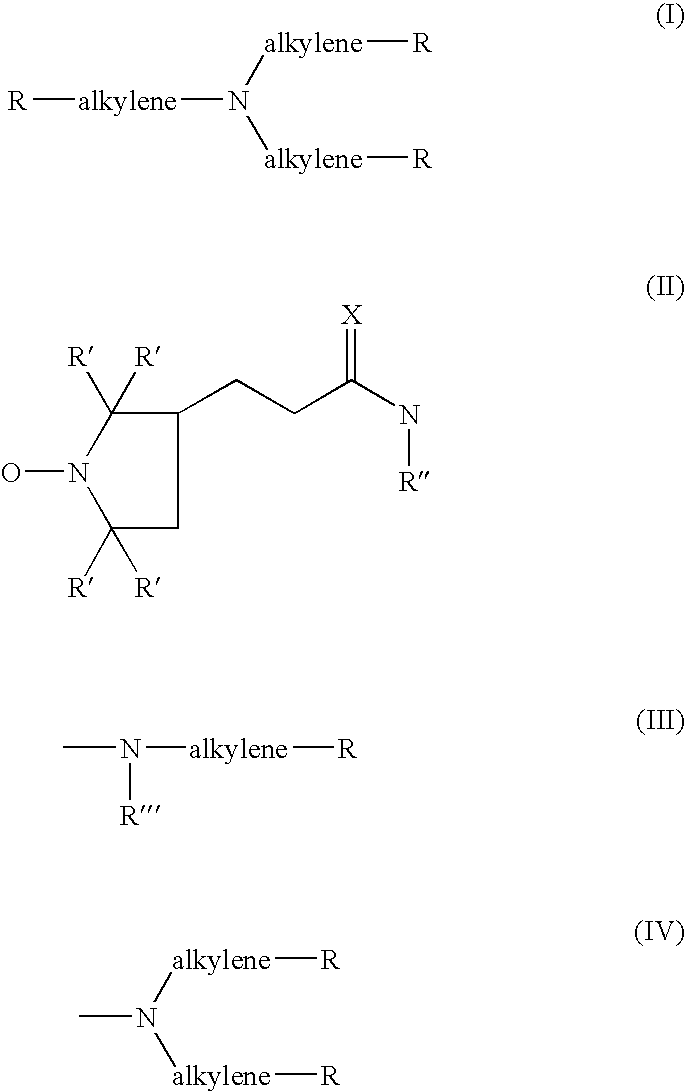Use of poly-nitroxyl-functionalized dendrimers as contrast enhancing agent in mri imaging of joints
- Summary
- Abstract
- Description
- Claims
- Application Information
AI Technical Summary
Benefits of technology
Problems solved by technology
Method used
Image
Examples
example 1
[0060] Synthesis of Dendrimer-Containing Nitroxides
[0061] 3-[(2,5-Dioxo-1-pyrrolidinyl)oxy]carbonyl]-2,2,5,5-tetramethyl-1-py-rrolidinyloxyl [3]. To a solution of 3-carboxy-2,2,5,5-tetramethyl-1-pyrro-lidinyloxyl [1], prepared as described in the literature, E. G. Rozantsev. Free Nitroxyl Radicals, Plenum Press, N.Y., pp. 203-206, (500 mg, 2.69 mmoles) dissolved in THF (50 mL) was added N-hydroxysuccinimide [2] (Aldrich Chemical Company, Milwaukee, Wis., 310 mg, 2.69 mmoles). After dissolution, 1,3-dicyclohexylcarbodiimide (Aldrich Chemical Company, 610 mg, 2.96 mmoles) was added. The reaction mixture was stirred for 2 days at room temperature, filtered and evaporated, in vacuo. The remaining oil was taken up in methylene chloride, filtered and evaporated in vacuo to dryness. The residue material was then washed with hot cyclohexane (3 times, 10 mL). The residual oil, dissolved in chloroform:hexane (80:20), was passed through a chromatographic column containing silica gel (Aldrich C...
example 2
[0066] In Vivo Pharmacokinetics of Joint Injected With Nitroxyl-Containing Dendrimer Using Magnetic Resonance Imaging (MRI)
[0067] Inject into both knee joints of a geriatric male (ca. 65-75 years; 70-80 kg), who has been diagnosed as osteoarthritic and is about to be treated medically for chronic severe pain and inflammation in both knees, 0.5 mL of a stock 100 .mu.M sterile solution sterile solution in 0.9% normal saline of a dendrimer of Formula (I) containing 32 terminal PROXYL-3-carbamido nitroxide groups [9] using a (gauge 25) needle. Then position the patent in a MR imager (1.5 Tesla MR system, SIGNA; General Electric Medical Systems, Milwaukee, Wis.) and obtain a scan of both knee joints in the conventional manner. At periodic intervals of about a month, repeat the procedure. Compare the succession of MR images thus obtained to evaluate the response of the knee joints to the treatment protocol.
[0068] Follow the above procedure in a peri-menopausal female whose blood chemistry...
example 3
[0072] In Vitro Stability of Dendrimer-Containing Nitroxides (Rate of Nitroxide Reduction).
[0073] In vitro rate of nitroxide reduction (Table 1) was undertaken using superoxide in the presence of a thiol, as an in vitro model for activated phagocytic cells. G. M. Rosen, B. E. Britigan, M. S. Cohen, S. P. Ellington and M. J. Barber, Biochim. Biophys. Acta, 969:236-241, 1988; G. M. Rosen and E. J. Rauckman. Biochem. Pharmacol. 26: 675-678, 1977; S. Pou, P. L. Davis, G. L. Wolf and G. M. Rosen, Free Rad. Res. 23: 353-364, 1995; and E. Finkelstein, G. M. Rosen and E. J. Rauckman, Biochim. Biophys. Acta, 802:90-98, 1984. For these determinations, nitroxides [S. Pou, et al, E. Finkelstein, et al., supra, and H. Kuthan, V. Ullrich and R. Estabrook, Biochem. J. 203: 551-558, 1982, (50 micromolar) were added to cysteine (200 micromolar) in the presence of a continued flux of superoxide (10 micromolar / min), generated by the action of xanthine oxidase on xanthine (400 micromolar) in Chelexed s...
PUM
 Login to View More
Login to View More Abstract
Description
Claims
Application Information
 Login to View More
Login to View More - R&D
- Intellectual Property
- Life Sciences
- Materials
- Tech Scout
- Unparalleled Data Quality
- Higher Quality Content
- 60% Fewer Hallucinations
Browse by: Latest US Patents, China's latest patents, Technical Efficacy Thesaurus, Application Domain, Technology Topic, Popular Technical Reports.
© 2025 PatSnap. All rights reserved.Legal|Privacy policy|Modern Slavery Act Transparency Statement|Sitemap|About US| Contact US: help@patsnap.com



